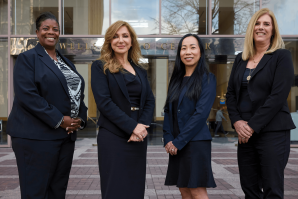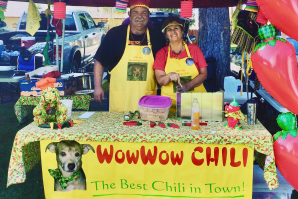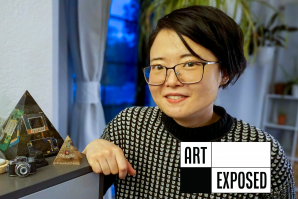Etched onto the top of Judi Moreno’s hand is a tattoo of a rose and diamond along with some very significant numbers. “It’s my sobriety date,” shares Moreno, a Sacramento schoolteacher. “On the other hand is a tiger. I knew once I got sober, I wanted to shine on my path to sobriety, but I wanted to guard it like a jungle cat.”
Judi Moreno stands next to her photos at a preview event for the
exhibit.

Once associated with fringe cultures and criminals, tattoos have long since moved into the mainstream, becoming a popular way for people to celebrate their lives and express themselves. Today, however, more women than men have tattoos. From delicate florals to elaborate sleeves, nearly a quarter of American women now sport permanent ink, compared to just 19 percent of men. While the field remains largely male-dominated, many female and nonbinary artists are carving out their own unique space in the industry and redefining tattoo culture on their own terms.
The unique history of “inked women” in California is explored in “Tattooed & Tenacious,” a traveling exhibit that opened in February at the Sacramento History Museum and continues its run through June. “For too long our narrative has focused on the white male pioneer,” explains Executive Director Delta Pick Mello. “We knew it was time to change that.”
From Indigenous tribes to circus performers of the ‘20s and ‘30s, to rock legend Janis Joplin, the exhibit explores the first women to embrace tattooing, includes photographs and stories of local women and their tattoos, and celebrates the first female tattooists and the work of local artists who continue to break barriers today.
Claiming identity
“I knew that I wanted all my tattoos to tell the story of my life and what I’ve been through,” says Moreno, who participated in the exhibit. With a colorful pastiche of designs across her back and arms, her tattoos detail her journey to sobriety and the special relationship she had with her father, a Grand Island farmer. “I’m not a painter, I’m not a musician,” she explains. “So this is a way to express myself in a meaningful manner.” Whether some people view tattoos on women negatively is of no concern to her. “If there’s any discriminatory treatment at this point, I don’t pay attention to it,” she says. “This is exactly who I am.”
Bold styles
In the past few decades, tattoos have become much more common and socially acceptable, especially for women. There was even a Tattoo Barbie, a collector’s doll with permanent ink, that caused quite a stir when it was released in 2011. Traditional “feminine” designs like hearts, butterflies and floral pieces remain popular, as well as recent trends like watercolor tattoos and extremely tiny, fine-line designs called micro tattoos. It even appears as though the “tramp stamp” — that much-maligned lower back tattoo that was popular in the late ‘90s and early aughts — could be making a comeback.
Folsom artist Ms. Ting is the owner of Shanghai Tattoo.

Folsom artist Zhou Dan Ting — otherwise known as Ms. Ting — says one thing she’s learned is to never judge a book by its cover. “The cutest little girl could have the most hardcore tattoo,” says Ting, a lifelong artist who grew up in a small city in China and started her career over 20 years ago. “There was no internet, nothing,” she shares.
A chance meeting with a Beijing tattoo artist inspired her to start learning to tattoo on her own. By 2003 she opened her first shop, and a few short years later she moved to Shanghai and opened the first Shanghai Tattoo. In 2018 she relocated to California, where she opened a second location in Folsom. The business recently moved to a new spot in the same district with more space for their growing team. Ting says tattoos are much more acceptable nowadays, and the designs she does are as diverse as the people who get them.
Ting focuses on photorealism — her website includes vivid, detailed portraits of everyone from the Incredible Hulk to Albert Einstein — as well as large, detailed Asian traditional pieces, Chinese calligraphy and watercolor designs. She loves dark, horror-themed designs — “Once I did a creepy priest with three eyes,” she laughs. “I’d love to do a larger scene from a horror movie.”
Building community
Born and raised in Sacramento, Maricelia Dominguez started tattooing over a decade ago. “This is the first time we’ve seen women represented in the industry like that,” shares Dominguez, co-owner of Les Tattoos (Ladies Empowering Sacramento), which she claims to be the largest LGBTQIA+ female-owned and operated shop on the West Coast. She and co-owner Chyna Anzaldua were delighted to be a part of the exhibit. “It makes me feel like Selena!” she laughs.
Six Bay Area tattoo artists collaborated on this hand-drawn
mannequin.

Also a talented painter, Dominguez’ tattooing style leans towards “gestural ornamental.” “I would say it’s a play on gesture drawing techniques and symmetry,” she explains. Redding native Anzaldua focuses on floral pieces, cover-ups and black-work, a unique style that relies solely on black ink to create designs.
After the pair met in 2018, they quickly realized they were kindred spirits, and it wasn’t long before they were making plans to start a business together one Friday over Moscow mules at a local bar. As two queer women of color, Dominguez explains, they had each experienced similar struggles coming up in the industry. They wanted to open a shop that would be a safe space for their community, where they could each thrive as artists and their team would have both the creative resources and the mental health resources to do the same.
“Some of the artists that come in are so scared because of their past experiences,” shares Anzaldua, a staunch advocate for mental health who explains apprentices aren’t always treated well. “There’s a lot of earning your place and showing respect.” In contrast, their goal is to advocate for the community but especially the artists that work there. “People are learning that you don’t have to tolerate the way it used to be,” says Anzaldua. “You’re an independent contractor, you do run your own business, so why don’t you?” Their mission, they say, is to set their team up for success so they have the tools to do that successfully.
The art and permanence
As the first female artist at Forever Tattoo in Midtown Sacramento, Liz Romano knows a few things about working in a male-dominated field. “A lot of people ask me if I’m a shop girl,” says Romano, who’s been tattooing for almost 18 years. The New Hampshire-born artist learned to draw from her father and got her start tattooing older friends in the punk rock scene when she was still a teen. “Some people would be offended by things that are said in shops,” she shares. “But I’m old school. We all razz each other here.”
Liz Romano is the first female artist at Forever Tattoo in
Midtown Sacramento.

With almost 20 years in the industry, Romano says tattooing is a tough road, and unless you’re willing to put in the work, she advises against it. Her apprenticeship at Sacramento’s now-defunct Bonehead Tattoo was a trial by fire. “It was my first day, and he said, ‘I’m going to show you how to set up a tattoo machine, and then I’m going to take it all apart,’” she recalls. “‘And if you can set it back up, you can tattoo me.’ Well, I set it up, and he had to get his tattoo that day,” she laughs. “They were pretty impressed!”
Her style leans towards the bold, black-lined traditional American style associated with 19th-century sailors, but Romano loves B-horror movies and drawing funny, outlandish designs. From disco aliens on roller skates to men lounging in martini glasses, she’s not afraid to inject humor into her designs. “They don’t all have to be so serious,” she says. “It’s going to be on your body forever! You’ve got to have some fun.”
What Romano says she loves most about tattooing is the art and permanence of it. “Most people don’t forget when, where and why they got their tattoo,” she explains. “It’s a constant reminder of where you were at one single moment or how you felt in that moment when you got it. I can’t imagine myself doing anything else.”
The “Tattooed and Tenacious” exhibit underscores a powerful message: Tattoos are a significant form of self-expression, and women are playing an increasingly important role in shaping the industry. The exhibit, which continues through June 2, 2024, celebrates not only the art of tattooing but also the tenacity of the women who wear and create them.
Stay up to date on business in the Capital Region: Subscribe to the Comstock’s newsletter today.
Recommended For You

Grass Valley Museum Tells Untold History of Women During the Gold Rush
Industrious nuns, international stars and well-educated orphans
In a county known for its wealth of Gold Rush-era museums, undoubtedly some of the most compelling stories from that time reside at a former orphanage hidden within the 160-year-old walls of the Grass Valley Museum.

What Women Bring
Women reflect on their road to leadership
These women’s paths have led them to positions of influence in their fields, and in some cases, they’ve made history in their roles.

The Chiliheads of Sacramento
National chili competitions are the spice of life for Capital Region retirees — including the founders of Jimboy’s
We’re like a biker gang, but we make chili,” says competitive chili cook Toni Groth, who travels across the country with her husband Mark to fight for the title of World’s Best. Plus, Jimboy’s gives us the chili scoop.

Art Exposed: Muzi Li Rowe
This mixed media artist and photographer explores culture through defunct technology
Whether it’s layers of tiny microchips or rows of dead batteries, each work in Muzi Li Rowe’s Magical Thinking series is like peering into a tiny museum where the most microscopic parts of now-defunct personal technology devices, from old Nokia flip phones to disposable cameras, become individual hallmarks of consumer culture.



